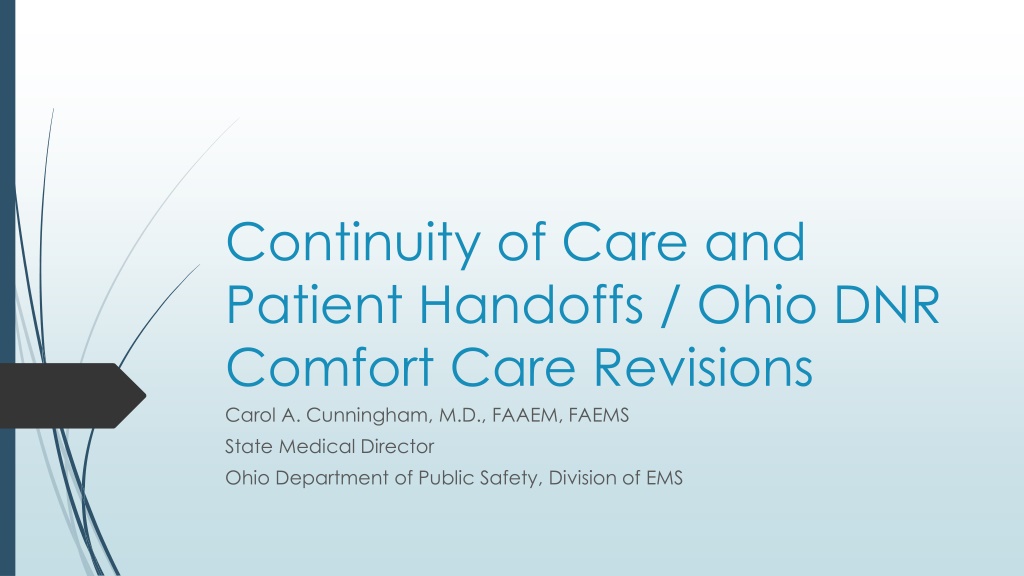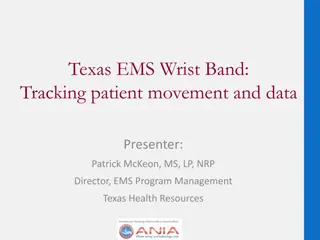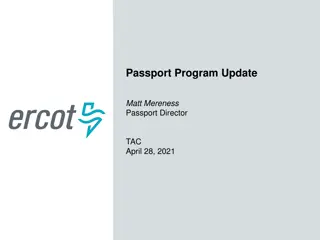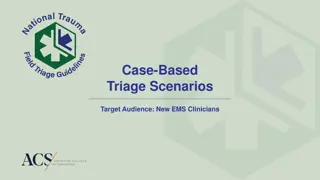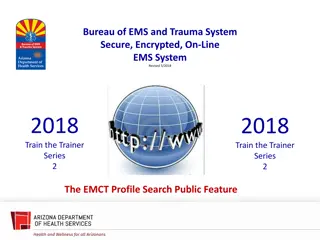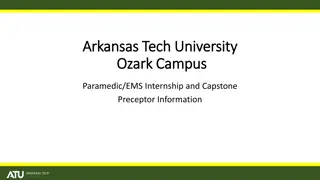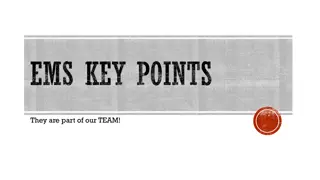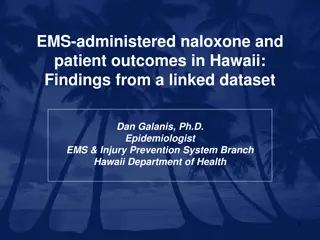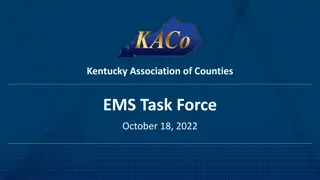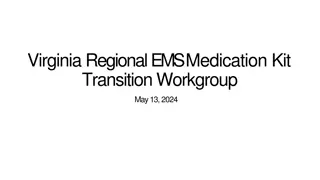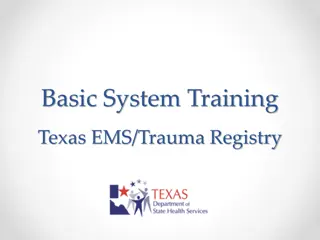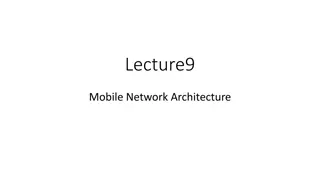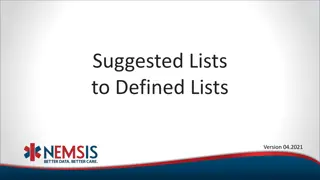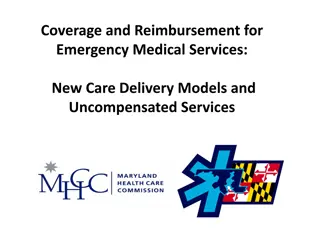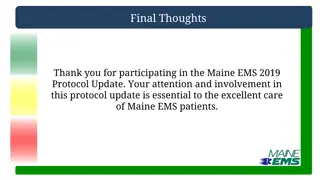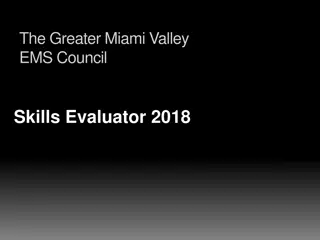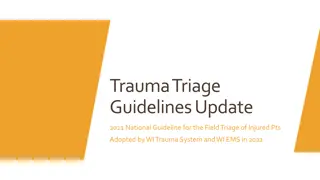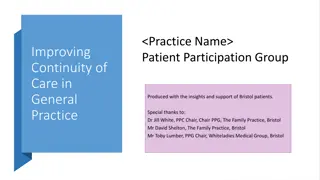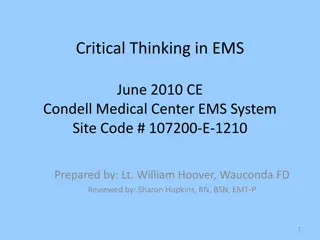Enhancing Patient Handoffs and Continuity of Care in EMS Settings
This document discusses the critical aspects of patient handoffs and continuity of care in emergency medical services (EMS) settings. It highlights the challenges faced during patient transitions and emphasizes the importance of effective communication and collaboration between EMS providers and receiving facilities. The content provides insights into common impediments to patient care transitions and offers recommendations for improving handoff processes. Various patient handoff tools are also introduced to facilitate seamless information exchange and enhance patient safety.
Download Presentation

Please find below an Image/Link to download the presentation.
The content on the website is provided AS IS for your information and personal use only. It may not be sold, licensed, or shared on other websites without obtaining consent from the author. Download presentation by click this link. If you encounter any issues during the download, it is possible that the publisher has removed the file from their server.
E N D
Presentation Transcript
Continuity of Care and Patient Handoffs / Ohio DNR Comfort Care Revisions Carol A. Cunningham, M.D., FAAEM, FAEMS State Medical Director Ohio Department of Public Safety, Division of EMS
Transition of Patient Care: Impediments Electronic patient care reports may not be available to the receiving facility until after critical patient interventions are required Lack of immediate availability of emergency department staff upon arrival Dysfunctional or lack of communication by any member of the EMS or emergency department team Physical absence of the medical specialist providing definitive care at the time of patient transfer Omission of pertinent elements of information Dispatch of EMS to another call prior to completion of the patient care report
Patient Handoffs Critical time for maintenance of patient care and safety A nidus of high risk and potential liability of performed poorly Should be performed in an consistent, efficient, and timely manner that minimizes the need for repetition by EMS providers Importance applies to all patient transfers regardless of type or severity of illness or injury Should ideally be inclusive of all members of the patient care team
Continuity of Care Patient handoffs are a shared responsibility of EMS and the receiving facility Many options are available to achieve this goal The ideal operational plan and selection of the method to maximize patient safety should involve a mutual agreement between all parties EMS providers EMS medical director Emergency department physicians and staff Medical specialists, particularly those that are tasked to time-critical diagnoses o o o o
Patient Handoff Tools Abbreviated written patient care note Team huddle/time out with pertinent information on white board DeMIST: Demographics, Mechanism of injury/illness, Injuries (sustained and suspected), Signs (including observation and monitoring), and Treatment given MIST: Mechanism or Medical complaint, Injuries or Ilness Identified, Signs and Symptoms, Treatments SBARR: Situation, Background (patient history), Assessment, Results of treatment given, Recommendation Inclusion of data that is specific to the decision-making process for time-critical diagnoses
State of Ohio DNR Comfort Care Program is overseen by the Ohio Department of Health Cited in Ohio Administrative Code 3701-62 Revisions were made in 2019 The new regulations became effective on September 1, 2019
State of Ohio DNR Comfort Care: Revisions Non-invasive airway management continues to be a permitted comfort care measure Oxygen delivery via non-invasive positive airway pressure devices (CPAP, BiPAP) have always been permitted but are now specifically cited in the regulation Physician assistants and advanced practice registered nurses may now sign the Ohio DNR Comfort Care order form
State of Ohio DNR Comfort Care: CONFLICT FOR EMS Currently, Ohio law only permits certified Ohio EMS providers to perform services via two avenues: 1. Pursuant to written or verbal authorization of physician or cooperating physician advisory board 2. Pursuant to authorization transmitted through a direct communication device (i.e., on-line medical direction) by a physician, physician assistant designated by a physician, or a registered nurse designated by a physician Ohio Revised Code 4765.35(D)(1), 4765.37(D)(1), 4765.38(C)(1), 4765.39(C)(1)
State of Ohio DNR Comfort Care: CONFLICT FOR EMS Legislation (laws) supersedes regulations (rules) While other healthcare providers may be able to accept an Ohio DNR Comfort Care order form that is signed by an advanced practice registered nurse or a physician assistant, this is not permitted by certified Ohio EMS providers. For certified Ohio EMS providers to accept an Ohio DNR Comfort Care order form, a physician s signature is required
EMS Medical Directors: Operational Advisory Ohio EMS providers are prohibited from accepting written orders from advanced practice registered nurses and physician assistants EMS medical directors should not provide written protocols directing EMS providers to accept Ohio DNR Comfort Care order forms signed by advanced practice registered nurses or physician assistants EMS medical directors, in partnership with their respective EMS agencies, are advised to consult their legal counsel for advice on an operational procedure
EMS Medical Directors: Administrative Advisory Analogous to certified Ohio EMS providers, all physician assistants and registered nurses typically function under the authorization of a licensed physician Physician assistants and advanced practice registered nurses are required to identify the authorizing physician on the Ohio DNR Comfort Care order form; however, they are currently not mandated to obtain an actual written co-signature from the physician A written signature from a physician is still required for Ohio EMS providers to accept the order in this scenario
EMS Medical Directors: Administrative Advisory Authorization of an advance directive is a distinctly different action than authorization of termination of resuscitation It is not advisable to authorize an advance directive for an individual for which a physician-patient relationship does not exist especially when the physician has no knowledge of the patient s name, physical assessment, medical history, personal wishes, or family dynamics An EMS medical director providing a carte blanche written protocol to accept Ohio DNR Comfort Care order forms signed by physician assistants or advanced practice registered nurses could potentially be perceived as the primary authorizing physician of record if litigation arises
EMS Providers: Operational Advisory By Ohio law, EMS providers shall only accept written orders from a physician EMS providers shall follow the Ohio DNR Comfort Care Protocol when presented with an Ohio DNR Comfort Care order form that is signed by a physician
EMS Providers: Operational Advisory Ohio EMS providers are prohibited from accepting written orders from advanced practice registered nurses and physician assistants Ohio EMS providers who are presented with an Ohio DNR Comfort Care order form that is not signed by a physician are advised to exercise one or both of the following options: Follow the written protocol for other forms of advance directives, e.g. attorney-generated documents such as living wills, that has been authorized by their EMS medical director Contact medical direction to discuss the potential for termination of resuscitation
